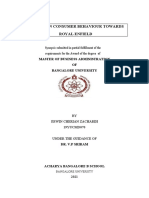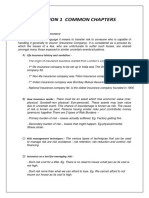Sec
Sec
Uploaded by
prasadmahajan26Original Description:
Copyright
Available Formats
Share this document
Did you find this document useful?
Is this content inappropriate?
Report this DocumentCopyright:
Available Formats
Sec
Sec
Uploaded by
prasadmahajan26Copyright:
Available Formats
SEC Classification From Wikipedia, the free encyclopedia The SEC Classification the classification of Indian consumers on the
basis of parameters. Traditionally the two parameters used to categorize consumers were: Occupation and Education of the chief wage earner (Head) of the households.The SEC classification,created in 1988, was ratified by Market Research Society of India (MRSI), is used by most media researchers and brand managers to understand the Indian consuming class.Originally developed by IMRB International as a way of understanding market segments, and consumer behavior it was standardized and adopted by the Market Research Society of India in the mid-1980s as a measure of socio-economic class and is now commonly used as a market segmentation tool in India. The new version is available at http://www.mruc.net/new-demographic-map-of-india.pdf. Please refer this one. In the older version,the SEC Classification consists of two grids
The Urban SEC Grid, which uses Education levels and Occupational criteria of the Chief Wage Earner (CWE) of a household as measures to determine socioeconomic classification, and segments urban India into 7 groups (A1 to E2) and
The Rural SEC Grid, which uses Education and Type of House (pucca, semi-pucca, and katcha) as measures of socio-economic class, and segments rural India into 4 groups (R1,R2,R3,R4)
This is based on the assumption that higher education leads to higher income thus higher consuming potential. But we know that this may not be true always. A trader or a retailer with no qualification can earn more income than a Post graduate executive, but SEC will categorize the traders/retailers not as SEC A1or A2. So, in order to combat this problem, the Government came up with the new SEC system. The new SEC system is based on two variables: 1. Education of the Chief Earner 2. The number of Consumer durables(pre-decided from a list) owned by the family.The list has 11 items ranging from "electricity and agricultural land" to cars and air conditioners. There are 12 grades in the new system starting from A1 to E3.The list of items are: Electricity connection, ceiling fan, LPG stove, two wheeler, colour TV, refrigerator, washing machine, personal computer,four wheeler, air conditioner and agricultural land.
These grids are used to determine the consumption preferences, and purchasing power of households, and are common tools used by social and business researchers working in India. The SEC grid does not use family income levels as a measure as this data is hard to collect and it has been demonstrated that education levels and occupation criteria in India are better determinants of consumer preference. The methodology used in these tools differs from the Household Potential Index, which measures consumption intensity.
Marketing Funda : Socio Economic Classification (SEC) Funda#3 : What is Socio Economic Classification ( SEC) ? A common classification that is used by marketers to describe the Indian population is the Socio Economic Classification ( SEC). SEC is the classification of Indian consumers on the basis of two parameters : Occupation and Education of the chief wage earner (Head) of the households.The SEC classification,created in 1988 ,was ratified by Market Research Society of India (MRSI) ,is used by most media researchers and brand managers to understand the Indian consuming class.
According to SEC, the U rban Indian households are classified on the basis of the two parameters Education and Occupation into SECA1,A2,B1,B2,C,D,E1,E2
In urban households, SEC A1 include those with graduation/post graduate holding senior positions like CEOs and Middle level managers and also those entrepreneurs having some college education and employs more than 10 staffs. The chart is self-explanatory. While the Rural Indian Households are classified into SEC R1,R2,R3,R4. In the rural classification, the parameters are Education of the Chief wage earner and the type of the house.
The SE C classification helps the marketers to identify segments tha t has high consuming potential.The high potential types : A1,A2, the medium ones and the bottom of pyramid ones. The SEC classification is used by Media planners to decide the media which gives the client maximum effectiveness. The research team at the me dia houses uses the NRS and IRS surveys' raw data to identify the reach of the media in these SEC segments and uses this input for pitching their campaign to large advertisers. Although this classification is popular for over 18 years, the classification has its negatives also since it takes only two parameters: education and occupation .This is based on the assumption that higher education leads to higher income thus higher consuming potential. But we know that this may not be true always. A trader or a retailer with no qualification can earn more income than a Post graduate executive, but SEC will categorize the traders/retailers not as SEC A1or A2. Hence Market research users council ( MRUC) has devised another classification called New Consumer Classification System( NCCS) which calculates a Household Premiumness Index ( HPI) which takes parameters like ownership and consumption of media services and products with other demographics. All these classifications create jargon that we teachers lecture and brand managers are still searching for the White Light that provides the key to understand the Indian consumer.
Chief Earner: Education (Q2)
No. of Durables (TRANSFER FROM Q1) Literate but no formal schooling/ School-Upto 4 years School5 to 9 years Some College (incla Diploma) but not Grad Graduate/ Post Graduate: General Graduate/ Post Graduate: Professional
Illiterate
SSC/ HSC
1 None 1 2 3 4 5 6 7 8 9+ E3 E2 E1 D2 D1 C2 C1 C1 B1 B1
2 E2 E1 E1 D2 C2 C1 B2 B1 A3 A3
3 E2 E1 D2 D1 C2 C1 B2 B1 A3 A3
4 E2 E1 D2 D1 C1 B2 B1 A3 A3 A2
5 E2 D2 D1 C2 C1 B1 A3 A3 A2 A2
6 E1 D2 D1 C2 B2 B1 A3 A2 A2 A1
7 E1 D2 D1 C2 B2 B1 A3 A2 A2 A1
Advertisement
It was the "family place" to go to since quick service restaurant chain McDonald's entered India. Children were a very important part of its target audience, with a lot of its advertising and menu especially targeting them. But now McDonald's is firmly talking about youth being its primary target consumers. Its advertising, new outlet interior designs and additions to the menu are all firmly targeted at the youth, though the outlets still have that defined family section. Both Amit Jatia, vice chairman, Hardcastle Restaurants, the franchisee that looks after the McDonald's business in the west and south markets in India, and Vikram Bakshi, MD and joint venture partner, McDonald's India -north and east markets - are in complete agreement that youth is the most important consumer segment for McDonald's in India today.
"In fact, we are in the process of re-imaging our restaurants to connect the brand with the youth segment, which is being done in phases. We are making the restaurants contemporary and relevant to the needs and sensibilities of the youth. Menu innovation is another area where we are focusing to introduce products and flavours relevant to this segment," said Bakshi. Jatia said: "The introduction of the spicy range of McDonald's offerings was specifically for the young adult target group. Our continuous efforts to keep our foods affordable and adding more filling fare is also because we are targeting youth. Our international McFlurry's dessert range, our expanding menu, breakfast on the go, are all directed at being relevant to the current market place, where youth has a predominant presence in India." Although one part of the business remains a joint venture (north and east) and the other has now become a franchise (Hardcastle, west and south), both companies in India have a common national marketing board that takes common marketing and advertising decisions at a national level. Regional marketing, however, varies for both companies that each have their regional marketing teams in place. "As our latest endeavour to engage the youth, we are about to unleash an 'augmented reality' initiative to promote McDonald's," Bakshi said. This initiative will see interactive digital imaging on the internet and mobile media, as well as at McDonald's outlets, though McDonald's is not willing to reveal much more about it yet. Jatia said that by 2014, McDonald's would have 450-500 outlets across India. By December, Hardcastle will have 130 outlets, while McDonald's India (north and east) currently has 100 outlets. Both are expanding aggressively.
Marketing stratergies
Sunday, 24 October 2010 Segmentation, Targeting and positioning model of Mcdonalds Segmentation, Targeting and positioning Model of McDonalds: In order to develop a marketing strategy, it is very important for company to understand its target customers. If the company can understand its customer then only it can communicate itself to their consumer Market. Better you know about your consumers, more effectively you could communicate and market them. McDonalds has segmented their products according to bases of Demographic, Psychographic and Behavioral. They have segmented their products and positioned their products according to kids, students and family. But they havent segmented their products according to the Adult target group. Also they havent started segment related to breakfast in every outlet.
Segmentation: Market segmentation is defined as dividing a single market into smaller segments. The basic reason for dividing the market into small segments is to make it simple to address the needs of smaller groups of customers and try to manufacture different products according to their consuming habits. Particularly it is done according to the people who have similar characteristics. It can be done on the basis of age, gender, lifestyle, region, etc. McDonalds in India segmentation it has done is on three different bases: 1) Demographic Segmentation: Kids, Family and Students McDonalds offers different products like Happy Meal which includes a free toy for kids. For families it has made different outlets and meals which are suitable for takeaways and drive-thru. McDonalds has made its environment which is suitable for students of school to hang out with their friends and can get their lunch at McDonalds. 2) Psychographic segmentation: Convenience and lifestyle McDonalds has adopted itself according to the convenience and lifestyle of the Indian consumers, as India has a huge vegetarian population so McDonalds came up with a different and new product line which includes items like Mc Veggie burger and Mc Aloo tikki Burger. They also made McDonalds as a place to relax and even for entertainment. 3) Behavioral segmentation: Occasions, for e.g. Birthday Parties of kids
McDonalds can get more customers by whom they can get most of the share of India Fast Food Industry but they should emphasis on their Targeting technique. To Get a Sustainable Advantage over their competitors McDonalds should introduce new as well as modified products which contains low cholesterol content in it. McDonalds has so much upcoming competition in Indian market that it should concentrate on Differentiation of its products increase its market size by implementing penetration pricing technique in which they should introduce the product with a lower price even lower than the market substitutes price. By this they can they can associate with their marketing objectives and can increase their sales and total revenue even in future. They should apply new positioning technique to create a new image in the minds of consumer about McDonald a place with healthy variants. McDonalds should observe present approach which they are following and subsequent the current advertising with healthy messages. This can be done by adding a more organized and expertise team which can work on healthy mindful advertisement. There advertising should contain all the benefits and healthy qualities about the products McDonalds is offering.
Positioning is a process of creating an image in the mind of consumers by which consumers can understand the uniqueness about your product when compared to competitors product. In India positioning of McDonalds has been directed as a Family restaurant. Then they started positioning according to the kids as well by introducing new advertising of toys with their products such as Happy Meal. In the start they made certain special efforts to not allow it to convert into a teenage and adults (20 to 24 years of age) hangout place. Now youngster and adults has became so use to fast foods that McDonalds should also target them and try to position McDonalds as a place for all. They should target adults also because they can pay for quality and variety of products. This will help McDonalds to be most recognizable brand in India for people of all ages. Or we can say that they should follow concept of undifferentiated marketing in which they should offer same marketing mix to mass audiences. This is due to the fact that in India has second largest population in the world and if they adopt this approach and try to do positioning according to this approach then they will be benefitted and their sales and revenue will surely increase.
You might also like
- Dymind DH36 - Operator's ManualDocument195 pagesDymind DH36 - Operator's ManualДенис Сахно80% (5)
- Oriental Insurance Bank Saathi Salient FeaturesDocument1 pageOriental Insurance Bank Saathi Salient FeaturesIron AlphaNo ratings yet
- Career Coaching Skills EnhancementDocument116 pagesCareer Coaching Skills EnhancementSta Lucia National High SchoolNo ratings yet
- Ic-38 Health Q&aDocument6 pagesIc-38 Health Q&askumaritesNo ratings yet
- Marketing Mix of Idbi Bank Insurance CompanyDocument16 pagesMarketing Mix of Idbi Bank Insurance CompanydimanshuNo ratings yet
- Frequently Asked Questions: Credit Guarantee Fund For Micro Units (CGFMU)Document4 pagesFrequently Asked Questions: Credit Guarantee Fund For Micro Units (CGFMU)Dhiraj NemadeNo ratings yet
- Liberalisation of Insurance Services RefinedDocument22 pagesLiberalisation of Insurance Services RefinedJojin JoseNo ratings yet
- Recruitment and Selection Process of Insurance CompaniesDocument85 pagesRecruitment and Selection Process of Insurance CompaniesAkhtar NawazNo ratings yet
- A Study On Consumer Behaviour Towards Royal EnfieldDocument7 pagesA Study On Consumer Behaviour Towards Royal Enfielddenny josephNo ratings yet
- EThical IssuesDocument21 pagesEThical IssuesNitu SainiNo ratings yet
- IC 27 Health Copy 79 140Document62 pagesIC 27 Health Copy 79 140Champaka Prasad RanaNo ratings yet
- Myntra - Media StrategyDocument13 pagesMyntra - Media StrategyPiyush KumarNo ratings yet
- Insurance ProjDocument20 pagesInsurance ProjMahesh ParabNo ratings yet
- Market Segmentation For Insurance: Users of Insurance Service: Marketing Information SystemDocument10 pagesMarket Segmentation For Insurance: Users of Insurance Service: Marketing Information SystemTejal GuptaNo ratings yet
- IC-24 - Legal Aspects of Life AssuranceDocument1 pageIC-24 - Legal Aspects of Life Assuranceaman vermaNo ratings yet
- Sources of FinanceDocument53 pagesSources of Financejessica0% (1)
- A Study On Whether Taxtion Is A Seeling Cool For Life InsuranceDocument7 pagesA Study On Whether Taxtion Is A Seeling Cool For Life InsuranceDEEPAKNo ratings yet
- Research Paper On The Topic Microfinance in AgricultureDocument12 pagesResearch Paper On The Topic Microfinance in AgricultureSukhmander SinghNo ratings yet
- TYBBI ProjectDocument57 pagesTYBBI ProjectPranav ViraNo ratings yet
- Abstract LicDocument1 pageAbstract LicAJAYNo ratings yet
- Executive Summary: M.S.R.C.A.S.C BangaloreDocument72 pagesExecutive Summary: M.S.R.C.A.S.C BangaloreSubramanya Dg100% (2)
- Ethics in Insurance Sector of IndiaDocument43 pagesEthics in Insurance Sector of IndianandiniNo ratings yet
- India's Auto Finance Market - 10 (1) .01.10Document26 pagesIndia's Auto Finance Market - 10 (1) .01.10Gogol SarinNo ratings yet
- Paytm As FintechDocument4 pagesPaytm As FintechShubham SinghNo ratings yet
- Star CompanyDocument15 pagesStar CompanyCandsz JcaNo ratings yet
- Adarsh Srivastava - 2C - Final Year ProjectDocument44 pagesAdarsh Srivastava - 2C - Final Year ProjectAdarsh SrivastavaNo ratings yet
- Rural InsuranceDocument45 pagesRural InsuranceAmeySalaskarNo ratings yet
- A Study On Customers Service Among Tamilnadu Mercantile Bank in Erode BranchDocument5 pagesA Study On Customers Service Among Tamilnadu Mercantile Bank in Erode BranchRahul SharmaNo ratings yet
- Jaiib PPT Downloaded From IibfDocument42 pagesJaiib PPT Downloaded From IibfSuranjit BaralNo ratings yet
- IC33 Revised Edition EnglishDocument513 pagesIC33 Revised Edition Englishhdsk82No ratings yet
- Edelweiss - Segmentation Targeting PositioningDocument3 pagesEdelweiss - Segmentation Targeting PositioningRiturajPaulNo ratings yet
- Foreign Exchange Market: Unit 2Document53 pagesForeign Exchange Market: Unit 2Gaurav ShahNo ratings yet
- Growth of Fintech Industry in IndiaDocument4 pagesGrowth of Fintech Industry in Indiasaurabhgupta5798No ratings yet
- Indian Marketing EnvironmentDocument9 pagesIndian Marketing EnvironmentRaju VeluruNo ratings yet
- Final ProjectDocument14 pagesFinal Projectkiru_makhija100% (1)
- A Lifecycle Framework of Green Iot-Based Agriculture and Its Finance, Operation, and Management IssuesDocument32 pagesA Lifecycle Framework of Green Iot-Based Agriculture and Its Finance, Operation, and Management IssuesRavi GowdaNo ratings yet
- Questionnaire - For Agents: Personal DataDocument8 pagesQuestionnaire - For Agents: Personal DataRachi JainNo ratings yet
- Reliance General Insurance CompanyDocument55 pagesReliance General Insurance Companyrajesh_dawat19910% (2)
- Individual Assignment - Facebook-Jio DealDocument6 pagesIndividual Assignment - Facebook-Jio DealParagNo ratings yet
- Export Performance of IndiaDocument31 pagesExport Performance of IndiaJeevan JainNo ratings yet
- Project Report Microfinance PDFDocument8 pagesProject Report Microfinance PDFkhageshNo ratings yet
- Exclusive Pitch DeckDocument21 pagesExclusive Pitch Deckalok kundaliaNo ratings yet
- Tata AigDocument50 pagesTata Aigpreeti93No ratings yet
- Innovation in Banking SectorDocument6 pagesInnovation in Banking SectorKashishNo ratings yet
- IC38 SushantDocument46 pagesIC38 SushantAyush BhardwajNo ratings yet
- Hutch To VodafoneDocument23 pagesHutch To Vodafonenayan_vetNo ratings yet
- Traditional VS Modern BankingDocument10 pagesTraditional VS Modern BankingVandana PrajapatiNo ratings yet
- Health InsuranceDocument18 pagesHealth Insurancekeerthi93No ratings yet
- A Report On: Customer Relationship Management of Idbi Federal Life InsuranceDocument95 pagesA Report On: Customer Relationship Management of Idbi Federal Life InsuranceamitNo ratings yet
- A Study On Awareness Towards Life Insurance PolicyDocument94 pagesA Study On Awareness Towards Life Insurance PolicykanujkohliNo ratings yet
- Go Speedy Go: InternshipDocument1 pageGo Speedy Go: InternshipSandeep KumarNo ratings yet
- 7 P's of ICICI BANKDocument13 pages7 P's of ICICI BANKSumit VishwakarmaNo ratings yet
- MCQs On Transfer PricingDocument16 pagesMCQs On Transfer PricingRaksha JagatapNo ratings yet
- Health Insurance in India-An Overview: K.Swathi, R.AnuradhaDocument4 pagesHealth Insurance in India-An Overview: K.Swathi, R.AnuradhaAnkit YadavNo ratings yet
- Pmsby PDFDocument3 pagesPmsby PDFmd mubarakNo ratings yet
- Small Finance BanksDocument2 pagesSmall Finance BanksUjjwal MishraNo ratings yet
- Consumer Durables Industry in IndiaDocument11 pagesConsumer Durables Industry in IndiaSiba PrasadNo ratings yet
- Financial Inclusion Schemes in IndiaDocument8 pagesFinancial Inclusion Schemes in IndiadheerajNo ratings yet
- The Four Walls: Live Like the Wind, Free, Without HindrancesFrom EverandThe Four Walls: Live Like the Wind, Free, Without HindrancesRating: 5 out of 5 stars5/5 (1)
- Full ProjectDocument54 pagesFull Projectprasadmahajan26No ratings yet
- Organizational Structure of The Coca Cola CompanyDocument37 pagesOrganizational Structure of The Coca Cola Companyprasadmahajan26No ratings yet
- Full ProjectDocument54 pagesFull Projectprasadmahajan26No ratings yet
- AMUL Strategy MCom ProjectDocument36 pagesAMUL Strategy MCom Projectprasadmahajan2675% (4)
- In May 1995, Maruti Got ISO 9002 Certification.: The Audit For This Coveredquality Assurance inDocument32 pagesIn May 1995, Maruti Got ISO 9002 Certification.: The Audit For This Coveredquality Assurance inprasadmahajan26No ratings yet
- "Organizational Behaviour of Nestle": A Project Report OnDocument35 pages"Organizational Behaviour of Nestle": A Project Report Onprasadmahajan26100% (1)
- SWADESDocument26 pagesSWADESprasadmahajan26No ratings yet
- FranchisingDocument38 pagesFranchisingprasadmahajan26100% (1)
- Project Report Indian WeddingDocument31 pagesProject Report Indian Weddingprasadmahajan2678% (9)
- AMUL Marketing MCom ProjectDocument40 pagesAMUL Marketing MCom Projectprasadmahajan26No ratings yet
- AMUL Marketing MCom ProjectDocument40 pagesAMUL Marketing MCom Projectprasadmahajan26No ratings yet
- AMUL Strategy MCom ProjectDocument36 pagesAMUL Strategy MCom Projectprasadmahajan2675% (4)
- Amul HRM Mcom ProjectDocument40 pagesAmul HRM Mcom Projectprasadmahajan2656% (9)
- Amul HRM Mcom ProjectDocument40 pagesAmul HRM Mcom Projectprasadmahajan2656% (9)
- Bajaj MKTG Proj Sem 2Document34 pagesBajaj MKTG Proj Sem 2prasadmahajan26No ratings yet
- Dabur Marketing StrategiesDocument31 pagesDabur Marketing Strategiesprasadmahajan26100% (1)
- AMUL Strategy MCom ProjectDocument36 pagesAMUL Strategy MCom Projectprasadmahajan2675% (4)
- Dabur Marketing StrategiesDocument31 pagesDabur Marketing Strategiesprasadmahajan26100% (1)
- A Report On Strategic Management Case of Coca ColaDocument48 pagesA Report On Strategic Management Case of Coca ColaRaza NaseemNo ratings yet
- Ingles 3 Bgu Mod1 Pag 7Document1 pageIngles 3 Bgu Mod1 Pag 7Jair LopezNo ratings yet
- Art and MusicDocument92 pagesArt and MusicKiên KiênNo ratings yet
- Chemistry Checkpoint Topics Part 1Document28 pagesChemistry Checkpoint Topics Part 1esteban ferrada silvaNo ratings yet
- Analysis of SIEM Systems and Their UsageDocument6 pagesAnalysis of SIEM Systems and Their UsagealexioNo ratings yet
- Tyro Turf Box Cricket Tornament Rule BookDocument3 pagesTyro Turf Box Cricket Tornament Rule BooknandolajasmitNo ratings yet
- Meeting 9 (TELEPHONE CONVERSATION)Document19 pagesMeeting 9 (TELEPHONE CONVERSATION)fauziah nazivaNo ratings yet
- Klasifikasi Delusi (Waham) Dan HalusinasiDocument4 pagesKlasifikasi Delusi (Waham) Dan HalusinasiGinaa aaaNo ratings yet
- Sandvik Pipe - Tube - Bar - Hollow Bar: Stock Program in StainlessDocument26 pagesSandvik Pipe - Tube - Bar - Hollow Bar: Stock Program in Stainlessalbejo_r9No ratings yet
- Gold Industry in India: Resources, Reserves, Mining, Metallurgy and EnvironmentDocument54 pagesGold Industry in India: Resources, Reserves, Mining, Metallurgy and EnvironmentSwapnendu GoonNo ratings yet
- Session 1Document48 pagesSession 1Gilbert AggreyNo ratings yet
- Maf671 Updated Marketing Report LatestDocument22 pagesMaf671 Updated Marketing Report LatestaisyahjapanieNo ratings yet
- Turbo X Motors CaseDocument3 pagesTurbo X Motors CasedeoverNo ratings yet
- I - Model 411 (Normal Category), Approved August 17, 1964 Model 411A (Normal Category), Approved January 26, 1967Document24 pagesI - Model 411 (Normal Category), Approved August 17, 1964 Model 411A (Normal Category), Approved January 26, 1967Ingeniero 1No ratings yet
- Mosquito Repellent Activity of Essential Oils of Aromatic PlantsDocument9 pagesMosquito Repellent Activity of Essential Oils of Aromatic PlantstmlNo ratings yet
- Orthodontic Management in Children With Special NeedsDocument5 pagesOrthodontic Management in Children With Special NeedsAnonymous LnWIBo1GNo ratings yet
- National Accreditation Board For Certification Bodies (NABCB)Document104 pagesNational Accreditation Board For Certification Bodies (NABCB)Said AbdallahNo ratings yet
- Free - Multiple - Intelligences - Test (Indo) SipDocument3 pagesFree - Multiple - Intelligences - Test (Indo) SiprendraNo ratings yet
- Host 1Document1,803 pagesHost 1Wisnu KristiadiNo ratings yet
- Fasting and Thyroid Test ResultsDocument4 pagesFasting and Thyroid Test ResultsRosNo ratings yet
- Mhada - Maharashtra.gov - in Sites Default Files Agreement For NOC From LADocument10 pagesMhada - Maharashtra.gov - in Sites Default Files Agreement For NOC From LArajivkvoraNo ratings yet
- UTechJa Summary of Courses of StudyDocument28 pagesUTechJa Summary of Courses of StudyJayBigHarryNo ratings yet
- Digital Modulation TechDocument63 pagesDigital Modulation Techgaurav_juneja_4No ratings yet
- Reading Bandung 1-30Document3 pagesReading Bandung 1-30Desi NpNo ratings yet
- Biomerieux Bact-Alert 3D - User ManualDocument350 pagesBiomerieux Bact-Alert 3D - User ManualJoseph War100% (2)
- Skeletal System Lab ReportDocument5 pagesSkeletal System Lab Reportapi-296603950100% (1)
- 06 MCTDocument100 pages06 MCTSompon ModekamNo ratings yet
- p222 1358 M H Klaiman Grammatical Voice Cambridge University Press 1991Document342 pagesp222 1358 M H Klaiman Grammatical Voice Cambridge University Press 1991Amparo Alemany100% (1)
- Споменик српске краљевске академије XVDocument76 pagesСпоменик српске краљевске академије XVIgorьNo ratings yet






































































































